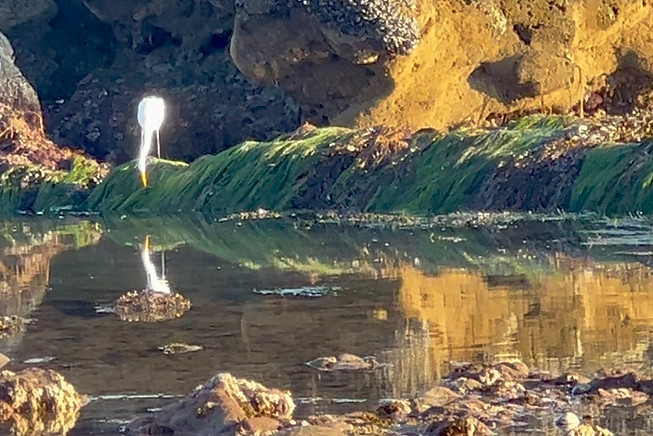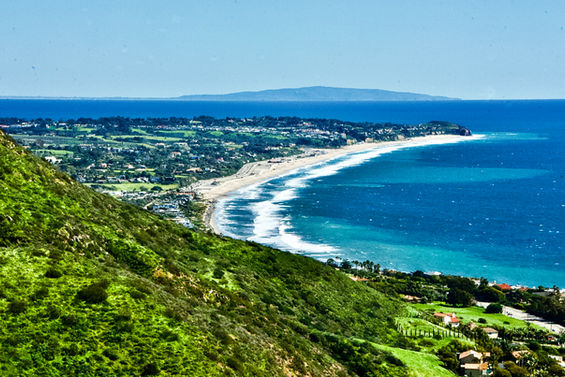

Save Our Sea
Fascinating Tidepools Reveal Ocean's Health
Tidepools are along almost every Malibu beach. They are in clusters of large sandstone, metamorphic and igneous rocks, or nested into crevices of hardened volcanic oozes that happened many thousands of years ago. Unlike so many coastal dead-zone East Coast tidepools, Malibu's tidepools have remained lush -- so far. Beach walkers who are curious about nature can easily
observe an abundance of anenomes, Sea Hares, Sea Cucumbers, Hermit Crabs, Periwinkles and Sea Stars, urchins, and various types of mussels, Longneck Barnacles, clams, and the ubiquitous Chamas shells. At low tide there are fields of emerald-green sea grass, once used by the Chumash and other native Americans to make baskets and cooking vessels. But our
coastline IS in a delicate condition, threatened not only by warming of sea waters, but by increased toxic runoff
from coastal herbicides, pesticides, gasoline, and car maintenance fluids. Not only are many Sea Stars suffering from the wasting disease, but they need protection to prevent the diminishing of species that will seriously harm the Earth itself.



Beautiful Sea Life is Delicate in Our Benthic Zone
The benthos refers to an ocean or lake layer made up of all the organisms living at the bottom of a body of standing or running water. This layer also is called the benthic zone, and it is the lowest layer of a lake, sea, stream, or river.
The benthos ranges from the shallow depths of the ocean, at and near the shoreline, to
Double click photos below for captions
extreme depths that humans have not yet been able to explore. So animals and plants living in the benthic zone are either crawling, burrowing, swimming near the bottom, or staying attached to rocks or seaweed. Although some benthic animals are predators, just as in other ocean layers, many animals rely on food sources that sink to the
bottom, such as inorganic matter or dead plants and animals.The zone above the benthos, where organisms that swim live, is called the pelagos, or the pelagic zone. All sea life is part of the animal food chain. If one being is affected all animals within the food chain are affected. We need to protect our oceans from constant human pollution.
Malibu Lagoon needs to be tested again to determine whether its bacteria level has changed since it was bulldozed in during the State's "Restoration and Enhancement" project in 2013.
At that time, a U.S. Geological Survey determined that the bacteria in it was NOT human waste from leaky septic tanks, as California State Parks had stated as a reason to "restore" the lagoon by bulldozing. Instead, USGS found that the bacteria
naturally resulted from the 72 species of birds attracted to the site's brackish estuary water.
State Lagoon Restorations Destroy Life, Water Flow
Often hanging out at the lagoon is a crowd of different pelicans (two species), two or three species of gulls, Black Skimmers, Cormorants, Oyster Catchers and the threatened Least Terns. The endangered Snowy Plovers actually nest on the pebbled beach between the sea and the southern part of the lagoon.
The Water Board has acted rashly to demand sewer systems along PCH. When a sewer line that serves thousands of homes and businesses breaks, the resulting contamination is much more severe than that of
an occasional small break in an old septic tank. Septic systems that met established standards and that are inspected regularly are safer for the environment than adding expensive sewer systems which, with breakage, will contaminate streams and benthic regions with concentrated toxins
Expansion of the approved system will enable additional traffic on an already overcrowded highway, plus additional truck traffic, as well as damaging developments and hillside cuts that will affect the entire coastline.
To see more, click thin white arrow near center inside edge of last photo
Surfers Share Spiritual Feelings of Awe for Sea Life
Surfers and water sports enthusiasts interrelate with nature on a regular basis and for many of them, their relationship with sea life has become almost mystical.
"That's one reason why we work so hard to keep the ocean clean and prevent pollution," said Cecil Markson in discussing his opposition to periodic bulldozing of estuary terrain and wildlife. The Malibu Lagoon estuary originally
was shaped by nature," he explained. "We need to




















